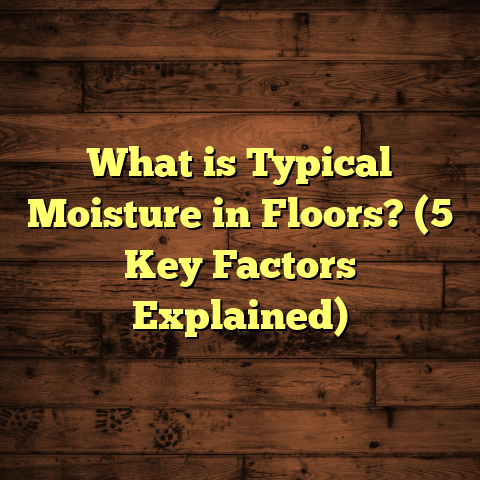What is a Floor Drain? (5 Key Benefits for Homeowners)
When I first walked through the front door of my new home, I was filled with excitement and a bit of nervousness. Moving into any house comes with the promise of comfort and security, but it also brings a flood of responsibilities—literally. One thing I didn’t think much about initially was the floor drains in the basement and laundry area. They just seemed like small metal grates on the floor that nobody really noticed. But over time, I learned how important these little fixtures are in protecting your home from water damage, mold, and other issues.
Have you ever come home to find a puddle of water on your basement floor after a heavy rain or a plumbing mishap? It’s stressful, right? The thought of water seeping into your foundation or ruining your belongings can be overwhelming. For me, those floor drains quietly saved me from several potential disasters. That’s why I want to share everything I’ve learned about floor drains with you—their purpose, benefits, installation tips, maintenance advice, and some real-life stories from my experience and research.
What is a Floor Drain?
At its simplest, a floor drain is a plumbing fixture designed to channel water away from a floor surface into your home’s drainage system. Think of it as a safety valve on your floor—ready to whisk away water before it causes damage or creates hazards.
Floor drains typically consist of three main parts:
- The Drain Body: This is the part embedded in the floor that connects to your plumbing pipes.
- The Grate or Cover: Usually made of metal or durable plastic, this sits flush with your floor and lets water pass through while keeping debris out.
- The Trap: A U-shaped bend inside the drain pipe that holds water at all times to block sewer gases from coming back up into your living space.
You’ll find floor drains in places prone to water spills or moisture accumulation—basements, utility rooms, laundry areas, garages, commercial kitchens, even bathrooms in some setups.
Why Floor Drains Are Not Just for Emergencies
Many people think floor drains only come into play during floods or major spills. But they’re active players every day. For example, in basements where humidity levels are high or where groundwater might seep in slowly, floor drains help capture and direct that moisture away. In laundry rooms, they’re there to catch leaks or overflow from washing machines before water spreads.
One thing I learned early on is that floor drains contribute to better air quality by preventing stagnant water puddles that breed mold and bacteria. This small feature affects your home’s health more than you might expect.
The 5 Key Benefits of Floor Drains for Homeowners
Let me walk you through five major reasons why I think every homeowner should pay attention to their floor drains—or consider installing them if they don’t have any yet.
1. Protects Your Home from Water Damage
Water damage is one of the most common and costly problems homeowners face. Whether it’s from a burst pipe, an appliance failure, or heavy rain flooding the basement, water can ruin flooring, walls, furniture, and even compromise your home’s structural integrity.
When my washing machine hose burst one afternoon while I was at work, I came back to find about an inch of water pooling on the laundry room floor. My heart sank for a moment—but then I noticed the floor drain was already working. It quickly channeled most of the water away before it could reach other rooms or soak into the foundation.
According to the Insurance Information Institute (III), water damage and freezing account for nearly 20% of all homeowner insurance claims. The average cost of water damage claims is over $10,000 per incident. Having a properly installed floor drain can reduce the chances of costly repairs by managing minor leaks before they escalate.
Here’s a key insight: floor drains act as your first line of defense against unexpected water events. You might not see them working daily, but when you need them most, they’re there.
2. Prevents Mold and Mildew Growth
One of my friends lived in an older home with a damp basement that smelled musty all year round. They tried everything—dehumidifiers, fans, even sealing cracks in the walls—but nothing worked well until they added new floor drains connected to an outdoor drainage system.
Mold and mildew thrive in moist environments and can cause serious health problems such as allergies and asthma. The Centers for Disease Control and Prevention (CDC) reports that about 10-50% of homes in the U.S. have dampness or mold problems.
Basements are especially vulnerable because they tend to be cooler and damper than other parts of the house. Without proper drainage, groundwater can seep through concrete walls or floors and create persistent moisture issues.
Floor drains help by collecting excess water before it saturates building materials. This keeps areas dry and less hospitable to mold spores.
3. Improves Home Hygiene
Let’s be honest—floors get dirty! Whether it’s muddy boots tracked in after rainstorms, spilled drinks during family gatherings, or pet accidents, messes happen.
Floor drains make cleaning these messes easier because you can wash down floors with water without worrying about puddles lingering or damage from moisture buildup.
I remember hosting a party once where kids spilled drinks all over our basement floor. Thanks to the floor drain nearby, cleaning took just minutes—I simply mopped up with water and it drained away quickly instead of creating sticky spots or attracting insects.
This means less bacteria buildup on floors and healthier living spaces overall.
4. Adds Value to Your Home
If you’re thinking about selling your home someday, features like well-maintained floor drains can boost buyer confidence.
A home with good drainage infrastructure signals careful maintenance and reduces risks associated with flooding or moisture damage—a big plus for potential buyers.
Some real estate agents suggest homes with basement floor drains sell faster and sometimes at higher prices because they’re seen as smart investments that protect the property.
I’ve also noticed that modern home builders increasingly include floor drains in basements or laundry rooms as standard features because buyers expect them now.
5. Simplifies Plumbing Maintenance
Floor drains aren’t just passive fixtures—they provide access points for checking and maintaining your home’s drainage systems.
For instance, if you notice slow draining sinks or appliances, you can sometimes open up the floor drain cover to inspect for clogs or flush out debris without calling a plumber right away.
One time I had a slow drain issue under my laundry sink. By removing the floor drain grate and cleaning out some trapped dirt inside the pipe nearby, I fixed the problem myself quickly.
This hands-on access can save time and money on plumbing repairs over the years.
Where Are Floor Drains Most Useful Around Your Home?
Understanding where to install floor drains depends on where water is likely to accumulate or cause damage. Here are some common locations:
Laundry Rooms
Washing machines are notorious for leaks or hose failures. Placing a floor drain nearby means any spilled water has an immediate escape route instead of flooding the room.
Basements
Basements are prone to groundwater seepage or flooding during heavy rains. Floor drains placed strategically at low points help collect water before it damages walls or floors.
Garages
If you wash your car at home or during winter when snow melts off vehicles indoors, garage floors can get wet often. Floor drains help keep these spaces dry and safe by draining away runoff.
Bathrooms
In some designs—like wet rooms or commercial bathrooms—floor drains replace traditional shower pans by allowing water to flow freely off the entire floor surface into drainage pipes.
Kitchens (Commercial & Residential)
Commercial kitchens rely heavily on floor drains for fast cleanup and sanitation. In homes with large kitchens or secondary prep areas (like a butler’s pantry), floor drains can be handy for spills or equipment drainage needs.
How Floor Drains Work: A Closer Look Inside
Let’s take a peek under the grate to understand what makes these drains tick.
The Trap – Your Shield Against Sewer Odors
Inside every good floor drain is a trap filled with water that acts as a barrier preventing sewer gases from escaping into your living area. When installed correctly, this trap always contains some water unless left dry for long periods without use.
To keep traps working properly:
- Pour water down unused drains every few weeks.
- Consider installing trap primers—devices that automatically add water when levels drop.
Drain Pipe Slope
For water to flow easily into the drain and away from your home, pipes must be installed at a slight downward slope—usually around 1/4 inch per foot—to encourage gravity-assisted drainage.
Improper slope causes standing water or slow drainage issues that can damage pipes over time.
Grate Types: Function vs Style
Grates come in various styles from simple flat covers to decorative designs matching flooring aesthetics:
- Heavy-duty grates: Used in garages or commercial spaces where vehicles or heavy equipment roll over.
- Standard grates: For residential basements or laundry rooms.
- Decorative grates: For visible interior spaces where appearance matters.
Choosing the right grate depends on location traffic and style preferences.
Installation Tips: DIY or Hire a Pro?
Installing floor drains requires some plumbing know-how but isn’t rocket science if you’re handy around tools.
For DIY Enthusiasts
Here’s what you’ll need:
- Properly sized drain body and grate.
- PVC or ABS piping compatible with your home’s plumbing.
- Tools: saws for cutting pipes, pipe cement/glue, level for slope checking.
- Safety gear: gloves and eye protection.
Steps include:
- Identify low point in area needing drainage.
- Cut concrete slab (if necessary) with proper permits.
- Install drain body connected to pipes with correct slope.
- Seal connections tightly.
- Replace concrete around drain body.
- Attach grate flush with floor surface.
If you haven’t done plumbing before, watch tutorial videos or consult guides specific to your local code requirements.
Hiring Professionals
If this sounds overwhelming (it often is), hiring licensed plumbers ensures proper installation according to building codes—preventing costly mistakes later on.
Professional installation usually costs between $300-$1,000 depending on location complexity but provides peace of mind knowing it’s done right.
Keeping Your Floor Drains in Top Shape: Maintenance Advice
I’ve learned that even though these systems are low-maintenance compared to other home components, neglecting them can cause problems down the road.
Here are simple steps I follow regularly:
- Clear debris: Remove leaves, dust, hair from grate covers monthly.
- Flush with hot water: Pour hot tap water down the drain occasionally to clear grease buildup.
- Use mild cleaning agents: Avoid harsh chemicals; instead, use baking soda & vinegar mixtures if needed.
- Check trap water levels: Pour fresh water into dry drains quarterly.
- Inspect after storms: Look for clogs or overflow signs after heavy rains.
- Install strainers: Catch hair/dirt before clogging pipes—especially useful in laundry rooms and bathrooms.
Regular upkeep keeps odors away and prevents backups before they start.
Data & Research Insights
Looking at data helps put things in perspective:
- The National Association of Home Builders found homes with proper drainage including floor drains had 30% fewer moisture-related inspection issues compared to those without.
- A case study from the Midwest Homeowner Association revealed adding basement floor drains reduced mold remediation expenses by an average of $1,200 per household over five years.
- According to FEMA reports on flooding damages nationwide, homes equipped with functional drainage systems experienced 40% less structural damage during flood events compared to those lacking such features.
These numbers back what I’ve seen firsthand: investing time and money into quality floor drainage has long-term benefits beyond just convenience—it protects your property value and health too.
Real Stories from Homeowners
The Flood That Almost Broke Us
One spring storm took everyone by surprise when our sump pump failed while we were out running errands. Water started creeping inside through cracks in our concrete basement floor.
Thanks to our properly installed floor drain connected to an external drainage line, most water drained away quickly before soaking carpets or walls—saving us thousands in repairs.
Without that drain working flawlessly under pressure, things could have turned out much worse.
The Slow Drain Mystery Solved
A friend called me frustrated because her laundry area sink was draining slowly despite repeated plunging. Upon inspecting her floor drain (which she had never bothered to check), we found hair and lint clogging part of the pipe system near the drain trap.
A quick cleanout restored normal flow without calling expensive plumbing services. Lesson learned? Floor drains serve as access points for troubleshooting too!
How Floor Drains Fit Into Broader Home Water Management Systems
While they’re vital individually, floor drains often work alongside other systems:
- Sump pumps that actively pump groundwater outside.
- French drains buried around foundations to intercept runoff.
- Gutter downspouts directing rainwater away from house walls.
- Backwater valves preventing sewage backup during floods.
Together these components create layers of defense against water intrusion—making your home safer no matter what nature throws at it.
Common Questions About Floor Drains
Q: Can I install a floor drain anywhere?
A: Ideally not; choose low points where water naturally collects or near potential leak sources like washers or sump pumps.
Q: How often should I clean my floor drains?
A: Monthly checkups work well for most households; more frequent if you have pets shedding hair or heavy debris exposure.
Q: What if my floor drain smells?
A: Usually means dry trap or clog—pour water down it first; if odor persists, inspect for blockages or cracked seals needing repair.
Q: Are all floor drains connected to sewer lines?
A: Typically yes; some may connect to stormwater systems depending on local plumbing codes but always verified by professionals during installation.
Final Thoughts on Caring for Your Floors—and Your Home
I’ve come to appreciate how these small but mighty fixtures quietly protect my home every day. They might not be glamorous or visible like hardwood floors or granite countertops—but their role is just as important in preserving comfort and safety long-term.
If you haven’t checked your existing floor drains lately—or don’t have any—it’s worth exploring how adding them could save headaches down the road. Whether you DIY or hire pros for installation and maintenance, investing time upfront pays off big when unexpected situations arise.
Feel free to reach out anytime if you want tips based on your specific house layout or need guidance picking materials suited for your climate and usage patterns. Helping homeowners protect what matters most—that’s what this is all about!





